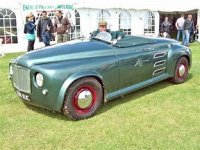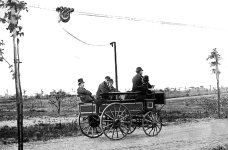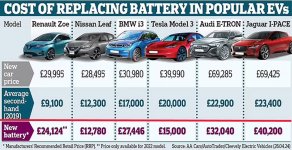You are using an out of date browser. It may not display this or other websites correctly.
You should upgrade or use an alternative browser.
You should upgrade or use an alternative browser.
Are we still convinced that electric vehicles are the best way forward?
- Thread starter Roscobbc
- Start date
Chuffer
CCCUK regional rep
During the 1800`s and the development of the new fangled railways , the Duke of Wellington was vehermently opposed to the railways as he proclaimed it would "incourage the great unwashed " to move freely about the country . A classic case of the class structure looking down its nose at us plebs ! Unfortunately the at the height of the UK Railway Building Mania between 1843 and 1845 many thousands of miles of track were constructed as business men , developers and chancers jumped on the band wagon as almost every town and village in the land wanted to be connected to the `new` transport system . Unfortunately many were doomed to be unprofitable and from the start and ran in direct competition to other railway companies linking the same places and were closed long before the infamous ` Beeching ` era . To make matters worse Dr. Beeching was only the `hatchet man ` hired by the government at the time to close down railway routes that had been systematically desimated by the government owned British Railways to make certain routes appear unprofitable to operate . The Great Central Railway mainline connecting the heartlands of the industrial north of England with London was a classic case that was closed in September 1966 ( which is actually now much of the route of the ill fated HS2 ) together with the Somerset & Dorset Railway route that carried thousands of holiday makers every year from the Midlands and further north down to Bournemouth via Bristol and Bath .It's interesting looking at that balance of ice, steam and electric vehicles in the USA in the early days of motoring. Electric vehicles were perfect for city use. Given that most major cities were on a railroad longer distance travel and vital supplies were already well catered for and the simplicity and reliability of electric cars were ideal for those local journeys for those who were able to afford a car. With the huge exponential growth of the rail network here in the UK in the late 1800's one would have thought the same scenario could have worked here in the UK.......but perhaps due to the endemic class structure here motorised transport for individuals was seen as something only for wealthy and upper classes.....while the great 'unwashed' could barely afford to repair their shoes, presuming they were able to afford to have bought them in the first place it took several decades and Henry Ford to show the way for the masses here.
And who was Minister of Transport at the time of all this ? None other than Ernest Marples who owned a large road construction company and was hell bent on getting everybody of the railways and into cars . Conflict of interest in politics as as old as the hills !!!
Chuffer
CCCUK regional rep
And when you got bored with driving you could pull off the highway and get pissed !!View attachment 25988
The Chrysler Turbine car had a lot of performance issues but could run on an extremely wide range of fuels from kerosene to jet fuel and including unleaded (didn't like leaded!).
The versatility was underline when the Mexican president ran one on tequila. That is a bio fuel.
Chuffer
CCCUK regional rep
One of the problems with gas turbine power was the high exhaust temperatures produced but a dare say that modern technology might find away to overcome that . British Railways built an experimental gas turbine locomotive called GT3 but it was short lived and would set fire wooden over bridges linking station platforms if came to a stand under them .Any form of reciprocating engine is toast due to the inefficiency of pistons stopping, starting and then going back the other way. In many ways it's a great shame the gas turbine never got developed for automotive use, given their popularity in aircraft and some ships. A miniature gas turbine installed in a gas/electric hybrid might have been interesting. I'm thinking range extender use on the motorway rather than 56 jet fighters screaming up your local high street!


teamzr1
Supporting vendor
We start in the 1830s, with Scotland’s Robert Anderson, whose motorized carriage was built sometime between 1832 and ’39.
Batteries (galvanic cells) were not yet rechargeable, so it was more a parlor trick (“Look! No horse nor ox, yet it moves!”) than a transportation device.
Another Scot, Robert Davidson of Aberdeen, built a prototype electric locomotive in 1837.
A bigger, better version, demonstrated in 1841, could go 1.5 miles at 4 mph towing six tons. Then it needed new batteries.
This impressive performance so alarmed railway workers (who saw it as a threat to their jobs tending steam engines) that they destroyed Davidson’s devil machine, which he’d named Galvani.
Batteries that could be recharged came along in 1859, making the electric-car idea more viable. Around 1884, inventor Thomas Parker helped deploy electric-powered trams and built prototype electric cars in England. By 1890, a Scotland-born chemist living in Des Moines, Iowa, William Morrison, applied for a patent on the electric carriage he’d built perhaps as early as 1887.
It appeared in a city parade in 1888, according to the Des Moines Register. With front-wheel drive, 4 horsepower, and a reported top speed of 20 mph, it had 24 battery cells that needed recharging every 50 miles. Morrison’s self-propelled carriage was a sensation at the 1893 Chicago World’s Fair, also known as the famed World’s Columbian Exhibition.
Morrison himself was more interested in the batteries than in mobility, but he’d sparked the imagination of other inventors.

Only place all electric vehicles really needed, is not on Earth
When NASA contracted Boeing to produce a “car” for use on the moon, electric was the obvious choice for an airless environment.
General Motors’ Delco division was a major subcontractor for the drive-control system and the motors on the Lunar Roving Vehicle
There were four DC motors, one in each wheel, making one-quarter horsepower apiece and capable of up to 10,000 rpm.
Four LRVs were built at a cost of $38 million, an overrun of 100 percent on the original $19 million projection.
Driven nine times (three excursions on each of three missions), it was the most exotic “car” ever.
First deployed on the Apollo 15 mission in 1971 (as shown here), the LRV used non-rechargeable silver-zinc potassium hydroxide batteries with a stated capacity of 121 amp-hours.
Steering at both axles also was by electric motor drawing on the same batteries.
Built of aluminum tubes and foldable in the center to stow onboard the Apollo lunar lander, it weighed 460 pounds (in Earth's gravity) without passengers, whose space suits had to be redesigned so they could sit in it.
The LRV could go 8 mph in theory, but the lunar surface demanded more cautious speed.
On Apollo 15, it moved about 17 miles over 3 hours, averaging less than 6 mph.
On Apollo 17, the last lunar mission, the LRV traveled about 22 miles total and the astronauts got nearly 5 miles away from their landing module.

Batteries (galvanic cells) were not yet rechargeable, so it was more a parlor trick (“Look! No horse nor ox, yet it moves!”) than a transportation device.
Another Scot, Robert Davidson of Aberdeen, built a prototype electric locomotive in 1837.
A bigger, better version, demonstrated in 1841, could go 1.5 miles at 4 mph towing six tons. Then it needed new batteries.
This impressive performance so alarmed railway workers (who saw it as a threat to their jobs tending steam engines) that they destroyed Davidson’s devil machine, which he’d named Galvani.
Batteries that could be recharged came along in 1859, making the electric-car idea more viable. Around 1884, inventor Thomas Parker helped deploy electric-powered trams and built prototype electric cars in England. By 1890, a Scotland-born chemist living in Des Moines, Iowa, William Morrison, applied for a patent on the electric carriage he’d built perhaps as early as 1887.
It appeared in a city parade in 1888, according to the Des Moines Register. With front-wheel drive, 4 horsepower, and a reported top speed of 20 mph, it had 24 battery cells that needed recharging every 50 miles. Morrison’s self-propelled carriage was a sensation at the 1893 Chicago World’s Fair, also known as the famed World’s Columbian Exhibition.
Morrison himself was more interested in the batteries than in mobility, but he’d sparked the imagination of other inventors.

Only place all electric vehicles really needed, is not on Earth
When NASA contracted Boeing to produce a “car” for use on the moon, electric was the obvious choice for an airless environment.
General Motors’ Delco division was a major subcontractor for the drive-control system and the motors on the Lunar Roving Vehicle
There were four DC motors, one in each wheel, making one-quarter horsepower apiece and capable of up to 10,000 rpm.
Four LRVs were built at a cost of $38 million, an overrun of 100 percent on the original $19 million projection.
Driven nine times (three excursions on each of three missions), it was the most exotic “car” ever.
First deployed on the Apollo 15 mission in 1971 (as shown here), the LRV used non-rechargeable silver-zinc potassium hydroxide batteries with a stated capacity of 121 amp-hours.
Steering at both axles also was by electric motor drawing on the same batteries.
Built of aluminum tubes and foldable in the center to stow onboard the Apollo lunar lander, it weighed 460 pounds (in Earth's gravity) without passengers, whose space suits had to be redesigned so they could sit in it.
The LRV could go 8 mph in theory, but the lunar surface demanded more cautious speed.
On Apollo 15, it moved about 17 miles over 3 hours, averaging less than 6 mph.
On Apollo 17, the last lunar mission, the LRV traveled about 22 miles total and the astronauts got nearly 5 miles away from their landing module.

teamzr1
Supporting vendor
Ford Motor Company reported a whopping $132,000 loss on each electric vehicle (EV) sold during the first three months of 2024, amassing a $1.3 billion loss.
The auto manufacturer’s electric vehicle unit revealed Thursday that they experienced a 20 percent decrease in sales volume and were forced to slash prices due to low consumer demand
The revenue for Ford’s EV car, the Model e, plunged by 84 percent to about $100 million, which the company blamed on EV price cuts across the auto industry.
“That resulted in the $1.3 billion loss before interest and taxes (EBIT), and the massive per-vehicle loss in the Model e unit,” the publication noted.
The recent figures are part of a trend of loss for Ford, with their Model e reporting a full-year EBIT loss of $4.7 billion on the sale of 116,000 units. This is an average loss of $40,525 per vehicle, and even that is just a third of the per-vehicle loss seen in the first three months of 2024.
Now, company officials are estimating that their EV division will lose a grand total of $5 billion this year alone, up from $4.7 billion last year.
“Americans don’t want EVs at levels Biden’s climate hysteria require,” author and businessman Andy Puzder wrote on X. “Ford’s EV Q1 losses soared to $1.3 billion, a ridiculous $132,000 per EV sold. All Ford’s profits came from combustion engine vehicle sales. Collectivist policies destroy prosperity.”
Ford announced earlier this month that the company will delay producing two new electric models, opting for hybrid vehicles instead.
“Many companies rushed in too fast with E.V.s that were too expensive and there was not as much of a market for them as they thought,” Sam Abuelsamid, transportation and mobility analyst at research firm Guidehouse Insights
The auto manufacturer’s electric vehicle unit revealed Thursday that they experienced a 20 percent decrease in sales volume and were forced to slash prices due to low consumer demand
The revenue for Ford’s EV car, the Model e, plunged by 84 percent to about $100 million, which the company blamed on EV price cuts across the auto industry.
“That resulted in the $1.3 billion loss before interest and taxes (EBIT), and the massive per-vehicle loss in the Model e unit,” the publication noted.
The recent figures are part of a trend of loss for Ford, with their Model e reporting a full-year EBIT loss of $4.7 billion on the sale of 116,000 units. This is an average loss of $40,525 per vehicle, and even that is just a third of the per-vehicle loss seen in the first three months of 2024.
Now, company officials are estimating that their EV division will lose a grand total of $5 billion this year alone, up from $4.7 billion last year.
“Americans don’t want EVs at levels Biden’s climate hysteria require,” author and businessman Andy Puzder wrote on X. “Ford’s EV Q1 losses soared to $1.3 billion, a ridiculous $132,000 per EV sold. All Ford’s profits came from combustion engine vehicle sales. Collectivist policies destroy prosperity.”
Ford announced earlier this month that the company will delay producing two new electric models, opting for hybrid vehicles instead.
“Many companies rushed in too fast with E.V.s that were too expensive and there was not as much of a market for them as they thought,” Sam Abuelsamid, transportation and mobility analyst at research firm Guidehouse Insights
Roscobbc
Moderator
The overall future picture for countries/economies that what were once stable and strong seems rather dismal. The world is we have always known it is financially 'levelling-up'. Countries that were once great producers with wealthy economies are being overtaken by 'emerging' economies (read China, other Far Eastern countries and India) Using poorly paid employees (and effectively slave labour) has always formed a part of the economies of wealthy countries. The manual staff essential for the physical work the produce all these products are needed less and less with the contininual rolling advancement of automation, robotics and AI control.
The manufacturing, production and economic powerhouse that the USA was always known as historically was one where the 'ordinary' person could work hard, be paid well for it and with low taxation spend his and her money on home produced products, supporting fellow Americans.
It was much the same here in the UK........but historically with a huge difference. The 'working classes' producing all these goods were exactly that, 'working classes', lowest of the low. Keeping wages low meant that employers could become rich and the goods produced were competitively priced to fuel huge export markets - and the UK's ruling classes made sure that the average Brit's continued to be poorly paid and effectively held back from advancing themselves - that was how the UK worked. Living on a small island with fewer resources meant that we (the Brit's and other landlocked Europeans) had to look 'outside' our countries for wealth.....hence the establishment of the colonies. America had huge swathes of land with oil, minerals, farmland and immigrants looking to better themselves. As with the rise and fall of the Roman Empire (and other nations before and after) strong countries and economies all eventually seem to loose their way, ultimately languishing and finallly failing. Where's it all going to go?
The manufacturing, production and economic powerhouse that the USA was always known as historically was one where the 'ordinary' person could work hard, be paid well for it and with low taxation spend his and her money on home produced products, supporting fellow Americans.
It was much the same here in the UK........but historically with a huge difference. The 'working classes' producing all these goods were exactly that, 'working classes', lowest of the low. Keeping wages low meant that employers could become rich and the goods produced were competitively priced to fuel huge export markets - and the UK's ruling classes made sure that the average Brit's continued to be poorly paid and effectively held back from advancing themselves - that was how the UK worked. Living on a small island with fewer resources meant that we (the Brit's and other landlocked Europeans) had to look 'outside' our countries for wealth.....hence the establishment of the colonies. America had huge swathes of land with oil, minerals, farmland and immigrants looking to better themselves. As with the rise and fall of the Roman Empire (and other nations before and after) strong countries and economies all eventually seem to loose their way, ultimately languishing and finallly failing. Where's it all going to go?
antijam
CCCUK Member
...whom we exploited ruthlessly for their raw materials then sold them back the consumer goods we'd manufactured from our imports.With the demise of empire the former colonies were free to exploit their resources as they saw fit and rather than export their natural resources they realised that it wasn't that difficult to convert them into the goods they needed themselves and cut out the 'middleman'. Years of being an industrial leader had given we Brits increasing wealth and higher and higher standards of living. Emerging economies starting from a much lower wage threshold could hardly fail to be highly price competitive with the traditional manufacturing countries. They were giving their labour force much lower wages than the traditional manufacturing leaders, like Europe and the USA, but these were nevertheless much higher than could be earned by pre-industrial labour.Living on a small island with fewer resources meant that we (the Brit's and other landlocked Europeans) had to look 'outside' our countries for wealth.....hence the establishment of the colonies.
The standard of living we enjoy today has priced us out of the majority of manufacturing markets. Only in areas where we can still demonstrate exceptional technical, manufacturing and commercial expertise do we still have productive industries.
There 'aint much you can buy these days that doesn't come with 'made in China/India' labels and that's only going to continue to grow.
Last edited:
teamzr1
Supporting vendor
Selling prices for used EVs are dropping into the crapper
Few of them showing as worth now and cost to replace the batteries
Damn, look at the costs to replace for a Jag

Also, new chargers people are buying are failing as soon as only 1 week of use
Many are requiring an electric source of 240 volts at 50 AMPs and where they live do not have the capability of adding that load to the main fuse panels :-(
Few of them showing as worth now and cost to replace the batteries
Damn, look at the costs to replace for a Jag

Also, new chargers people are buying are failing as soon as only 1 week of use
Many are requiring an electric source of 240 volts at 50 AMPs and where they live do not have the capability of adding that load to the main fuse panels :-(
Roscobbc
Moderator
There's some wild 'disparity' in that chart comparing initial vehicle purchase price vs replacement battery cost vs brand 'identity' premium.
One would resonably presume that aftermarket battery suppliers will enter the market, sensing a profit (even at discounted supply prices) and ultimately brand manufacturers being forced to compete and reduce their prices.
Irrespective of all that - electric vehicle owners (even early Tesla owners with 'free' supercharging) will surely calculate the financial benefit of 'supposedly' less expensive battery 'charging' costs - vs battery 'replacement' costs (if keeping the electric vehicle long term/ and/or purchasing sourcing a 'used' vehicle)
The overall pence/£'s (cent/dollar) per mile costs of longer term electric vehicle ownership may be far less financially 'advantageous' than people realise.
If you drive a company sourced electric vehicle (whether directly purchased, leased or contract hired) none of this will matter as the vehicle will be on a mileage controlled, 2,3, 4, perhaps 5 year contract with the final (perhaps significantly reduced) vehicle 'selling-off' price having already beeing factored in to the users monthly costs. One presumes we'll see these vehicles on the second hand market with refurbished/new batteries?
One would resonably presume that aftermarket battery suppliers will enter the market, sensing a profit (even at discounted supply prices) and ultimately brand manufacturers being forced to compete and reduce their prices.
Irrespective of all that - electric vehicle owners (even early Tesla owners with 'free' supercharging) will surely calculate the financial benefit of 'supposedly' less expensive battery 'charging' costs - vs battery 'replacement' costs (if keeping the electric vehicle long term/ and/or purchasing sourcing a 'used' vehicle)
The overall pence/£'s (cent/dollar) per mile costs of longer term electric vehicle ownership may be far less financially 'advantageous' than people realise.
If you drive a company sourced electric vehicle (whether directly purchased, leased or contract hired) none of this will matter as the vehicle will be on a mileage controlled, 2,3, 4, perhaps 5 year contract with the final (perhaps significantly reduced) vehicle 'selling-off' price having already beeing factored in to the users monthly costs. One presumes we'll see these vehicles on the second hand market with refurbished/new batteries?

